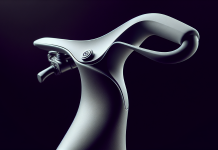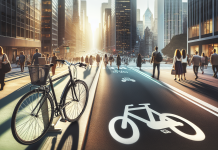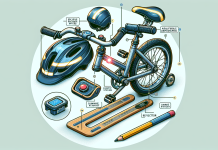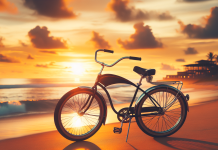Cruiser bikes, also known as beach cruisers, have a distinct charm that sets them apart from other types of bicycles.
With their comfortable wide seats, wide handlebars, and laid-back design, cruiser bikes offer a relaxed and enjoyable riding experience. Unlike road bikes built for speed or mountain bikes designed for rough terrains, cruiser bikes prioritize comfort and style.
Whether cruising down the boardwalk or exploring your neighborhood, a cruiser bike is the perfect companion for leisurely rides and effortless enjoyment. So, hop on a cruiser bike and embrace the unique blend of comfort, style, and relaxation these bikes offer.
Table of Contents
Cruiser Bike Features
Comfortable Riding Position
One of the standout features of cruiser bikes is their comfortable riding position. Unlike other bikes that force riders into a hunched or forward-leaning position, cruiser bikes are designed to keep riders upright and relaxed. This makes them perfect for leisurely rides, allowing riders to enjoy the journey without putting unnecessary strain on their neck, back, and shoulders.
Upright Handlebars
To further enhance the comfortable riding position, cruiser bikes are equipped with upright handlebars. These handlebars are positioned higher than other bikes, allowing riders to maintain a natural grip and reducing strain on their wrists. The upright handlebars also provide better control and stability, making cruiser bikes easy maneuvering even at slower speeds.
Wide and Soft Saddles
Cruiser bikes are known for their comprehensive, soft saddles prioritizing comfort over speed. Unlike the narrow and firm saddles on road bikes, cruiser bike saddles offer a plush seating experience that allows riders to settle in and enjoy their ride for extended periods. The comprehensive design also helps evenly distribute the rider’s weight, reducing pressure points and preventing discomfort.
Sturdy Construction
Built to withstand leisurely rides and various terrains, cruiser bikes are known for their sturdy construction. Every aspect of a cruiser bike is designed with durability in mind, from the heavy-duty frames to the vital components. This ensures that riders can rely on their cruiser bikes for years, making them a long-lasting investment in leisure and comfort.
Heavy-Weight Frame
Unlike lightweight bikes designed for speed, cruiser bikes feature heavy-weight frames that provide stability and durability. The frame’s weight adds to its overall sturdiness, making it better equipped to handle bumps and minor impacts. While the heaviness of the frame may not make cruiser bikes the ideal choice for racing or maneuvering through tight spaces, it contributes to the bike’s robustness and ability to handle various terrains.
Balloon Tires
Cruiser bikes are known for their distinctive balloon tires, which are more comprehensive and have a larger volume than those found on other types of bikes. The balloon tires contribute to the smooth and comfortable ride provided by cruiser bikes, absorbing shocks and vibrations from uneven terrains. Additionally, the wider surface area of the tires increases traction, providing stability and a sense of control, especially on smooth pavements.
Coaster Brakes
Another feature that sets cruiser bikes apart is the use of coaster brakes. Unlike traditional hand-operated brakes, coaster brakes are activated by pedaling backward. This design simplifies the braking process and eliminates the need for hand coordination, making cruiser bikes more accessible, especially for riders who may have difficulty using handbrakes. The ease of use and reliability of coaster brakes further enhance cruiser bikes’ relaxed and leisurely riding experience.
Purpose and Design
Casual Riding
Cruiser bikes are designed for casual riding, making them the perfect choice for those looking to savor the journey rather than rush to their destination. Whether a leisurely ride through the park or a relaxing cruise along the beach, cruiser bikes are meant to be enjoyed at a comfortable and relaxed pace; with their comfortable features and laid-back design, they encourage riders to embrace a slower and more enjoyable way of getting around.
Beach Cruiser Style
One of the most iconic aspects of cruiser bikes is their beach cruiser style. Inspired by bikes seen along sunny coastlines, cruiser bikes often feature vibrant colors, retro designs, and stylish details that exude a sense of fun and leisure. The beach cruiser style not only adds to the aesthetic appeal of the bike but also serves as a visual reminder of the carefree and relaxed atmosphere often associated with coastal living.
Vintage and Nostalgic Look
Cruiser bikes have long been associated with a vintage and nostalgic look, evoking a sense of nostalgia for simpler times. With their classic and timeless design, cruiser bikes transport riders back to an era when life was less complex and more carefree. This vintage look makes cruiser bikes visually appealing and adds to the overall riding experience, allowing riders to feel as if they are stepping into a bygone era.
Minimalistic Features
Unlike other types of bikes that may be equipped with multiple gears, suspension systems, and advanced technologies, cruiser bikes embrace a minimalistic approach. With limited gear options and a focus on simplicity, cruiser bikes prioritize ease of use and a low-maintenance experience. This minimalist design adds to the overall charm of cruiser bikes and aligns with their purpose of providing a relaxing and unhurried ride.
Limited Gear Options
As mentioned earlier, cruiser bikes typically have limited gear options compared to other types of bikes. While this may be seen as a drawback for riders seeking speed or versatility, it perfectly suits the laid-back nature of cruiser bikes. With fewer gears to worry about, riders can focus on enjoying the ride without constantly shifting gears. The limited gear options also contribute to the simplicity and ease of use that cruiser bikes are known for.
Use and Terrain
Leisurely Rides
Cruiser bikes are designed for leisurely rides, making them ideal for those who want to enjoy the scenery, soak in the fresh air, and embrace a more relaxed riding experience, whether a quiet ride through the neighborhood or a Sunday afternoon cruise along a scenic path, cruiser bikes are meant to be enjoyed at a comfortable pace, allowing riders to appreciate their surroundings fully.
City Streets
While cruiser bikes may not be designed for high speeds or strenuous rides, they are well-suited for city streets. With their comfortable riding position, cruiser bikes provide an enjoyable, stress-free way to navigate urban environments. They allow riders to effortlessly meander through city streets, giving them the freedom to explore their surroundings and discover new neighborhoods at a relaxed pace.
Coastal Areas
As the name suggests, cruiser bikes are trendy in coastal areas. With their beach cruiser style and relaxed design, these bikes perfectly complement the laid-back atmosphere of beach towns. From cruising along the boardwalk to exploring seaside trails, cruiser bikes allow riders to fully immerse themselves in the coastal lifestyle, making them a beloved choice for residents and tourists alike.
Flat Terrain
Cruiser bikes are best suited for flat terrains, where their comfort and efficiency genuinely shine. The relaxed riding position, wide and soft saddles, and balloon tires contribute to a smooth and enjoyable ride on level ground. Whether it’s a paved path in the park or a quiet suburban street, cruiser bikes provide a comfortable and leisurely riding experience in areas with minimal inclines or challenging terrain.
Smooth Pavement
With their emphasis on comfort and ease of use, cruiser bikes are particularly well-suited for riding smooth pavements. The balloon tires use a heavy-weight frame to absorb shocks and vibrations, resulting in a smooth and stable ride even on less-than-ideal surfaces. Cruiser bikes glide effortlessly on smooth pavements, making them a popular choice for urban environments, whether on a freshly paved road or a well-maintained bike path.
Limited Off-Roading Capability
While cruiser bikes can handle some uneven surfaces or packed dirt paths, they are not designed for extensive off-roading. The heavy-weight frame and balloon tires provide stability and shock absorption, but cruiser bikes lack the advanced suspension systems and aggressive tread patterns of mountain bikes. As such, it is best to stick to smoother terrains and avoid more challenging off-road trails when riding a cruiser bike.
Speed and Efficiency
Relaxed and slow-paced
Cruiser bikes are all about embracing a relaxed, slow-paced ride, prioritizing enjoyment over speed. Unlike road bikes or mountain bikes built for fast and efficient performance, cruiser bikes encourage riders to take their time, meander along their route, and absorb the sights and sounds of their surroundings. With their comfortable features and laid-back design, cruiser bikes provide a welcome escape from the rush and stress of our fast-paced world.
No Need for High Speeds
One of the critical differentiators of cruiser bikes is their lack of emphasis on high-speed performance. While other types of bikes may focus on achieving maximum speed, cruiser bikes are more concerned with providing a comfortable and enjoyable ride. The limited gear options and relaxed riding position make it clear that cruiser bikes are not meant to be ridden at high speeds but at a leisurely pace that allows riders to appreciate their surroundings fully.
Not Designed for Racing
Unlike road bikes and some mountain bikes that are specifically designed for racing or endurance events, cruiser bikes are not intended for competitive cycling. Their heavy-weight frames and relaxed riding position are not optimized for the speed and agility required in racing scenarios. Cruiser bikes are meant to offer a more laid-back and enjoyable riding experience, with racing and speed taking a backseat to comfort and leisure.
Efficiency Sacrificed for Comfort
In favor of providing a more comfortable ride, cruiser bikes may sacrifice some efficiency and speed. The heavier weight of the bike and the broader tires can require more exertion from the rider. However, this trade-off is intentional, as cruiser bikes prioritize comfort and relaxation over high-performance riding. For those seeking a bike that allows them to enjoy the journey rather than reach their destination quickly, the sacrificed efficiency is a worthwhile compromise.
Popular Cruiser Bike Variations
Classic Cruiser Bikes
Classic cruiser bikes embody the timeless and nostalgic design that cruiser bikes are known for. With their iconic curved frames, vibrant colors, and retro-inspired details, classic cruiser bikes capture the essence of leisurely rides by the beach or through quaint neighborhoods. They often feature wide handlebars, balloon tires, and comfortable saddles, providing the ultimate vintage riding experience.
Beach Cruiser Bikes
Beach cruiser bikes are designed explicitly for coastal environments and beachfront adventures. They often feature rust-resistant frames and components to withstand exposure to saltwater and sand. Beach cruiser bikes typically have a more relaxed frame geometry, allowing riders to hop on and off the bike without hassle. With their vibrant colors and coastal-inspired designs, beach cruiser bikes perfectly complement beach towns’ laid-back and carefree atmosphere.
Lowrider or Chopper Bikes
Chopper bikes, also known as lowrider bikes, take cruiser bike design to the next level with their unique and custom features. These bikes are stylish, often featuring elongated frames, exaggerated handlebars, and intricate details like custom paint jobs and chrome accents. Chopper bikes are more than just modes of transportation – they are works of art that allow riders to make a bold and personal statement while enjoying a comfortable ride.
Stretch Cruiser Bikes
Stretch cruiser bikes are a variation of cruiser bikes that feature an extended frame, allowing for a more relaxed and laid-back riding experience. These bikes often have elongated handlebars and seating positions that place the rider in an ultra-comfortable and reclined position. Stretch cruiser bikes stand out with their elongated frames, giving them a distinctive and eye-catching look that will turn heads wherever they go.
Differentiation from Mountain Bikes
Design and Purpose
Cruiser bikes and mountain bikes are designed with different purposes in mind. While mountain bikes are built to tackle challenging off-road terrain, cruiser bikes prioritize comfort and leisurely rides on flat or paved surfaces. Each bike’s frame designs, components, and features are tailored to meet these distinct purposes, resulting in noticeable differences between the two.
Tires and Tread Patterns
One of the significant differences between cruiser and mountain bikes lies in their tires and tread patterns. Mountain bikes have knobby and aggressive tread patterns to provide traction and control on loose, uneven terrain. In contrast, cruiser bikes feature wider and smoother tires with minimal tread, designed to glide effortlessly on smooth pavements and provide a comfortable ride.
Gearing System
Mountain bikes typically have a wide range of gears to navigate through varying terrains and inclines. The gearing systems on mountain bikes are designed to give riders the power and control to conquer steep climbs and descend challenging trails. On the other hand, cruiser bikes often have limited gear options, as they are primarily built for flat or gently sloping terrain, where the need for multiple gears is less essential.
Suspension
One of the most noticeable differences between cruiser and mountain bikes is their suspension systems. Mountain bikes have front and rear suspension systems to absorb shocks and bumps encountered on off-road trails. These suspension systems enhance rider comfort and control, allowing them to easily tackle rough terrains. In contrast, cruiser bikes typically do not have suspension systems, as they prioritize comfort on smooth pavements rather than shock absorption on off-road trails.
Weight and Frame
Mountain bikes are often lighter in weight compared to cruiser bikes. The lighter weight of mountain bikes allows for better acceleration and maneuverability, making them suited for speed and agility on challenging trails. In contrast, cruiser bikes have heavy-weight frames that provide stability and durability. The heavier frames contribute to the robustness of cruiser bikes, making them better equipped to handle minor impacts and provide a smoother ride on even surfaces.
Handlebar Position
Mountain bikes typically have handlebars positioned lower than the saddle, promoting a more forward-leaning and aggressive riding position. This position allows riders to shift their weight and maintain balance while riding through rough terrains. In contrast, cruiser bikes have upright handlebars, placing riders in a more relaxed and comfortable position. The upright handlebars are positioned higher than the saddle, giving riders a clear view of their surroundings and reducing strain on their wrists and back.
Terrain Compatibility
Mountain bikes are specifically designed to handle a wide range of terrains, including rugged trails, rocky paths, and steep inclines. They are built to provide ample traction, control, and stability in unpredictable off-road conditions. In contrast, cruiser bikes are best suited for flat terrains and smooth pavements. While they can handle packed dirt paths or slightly uneven surfaces, cruiser bikes provide a smooth and enjoyable ride in areas with minimal challenges or steep inclines.
Differentiation from Road Bikes
Design and Purpose
Cruiser bikes and road bikes are designed with different purposes in mind. Road bikes are built on paved roads for speed, efficiency, and long-distance rides. They feature lightweight frames, aerodynamic designs, and multiple gears to allow riders to pedal faster and cover more ground with less effort. In contrast, cruiser bikes prioritize comfort, leisure, and a relaxed riding experience, suiting them more to shorter rides and a slower pace.
Handlebars
One of the most noticeable differences between cruiser and road bikes is the handlebars. Road bikes typically have drop handlebars, which promote an aerodynamic riding position. Riders grip the hoods or the drops of the handlebars, allowing them to adjust their hand positions for better efficiency and control. In contrast, cruiser bikes have upright handlebars that prioritize comfort and a more relaxed riding position, providing riders with a clear view of their surroundings and reducing strain on their wrists and back.
Tires
Road bikes feature narrow, smooth tires optimized for speed and minimal rolling resistance on paved roads. These tires have a larger diameter, reducing the contact patch with the road surface and allowing for smoother and faster rides. On the other hand, cruiser bikes have broader and softer tires, often with balloon-like proportions. The wider surface area of the cruiser bike tires increases traction, provides stability, and contributes to the overall comfort of the ride.
Gearing System
Road bikes are equipped with a wide range of gears, allowing riders to pedal at different speeds and tackle varying terrains efficiently. The multiple gears enable road bike riders to easily adjust their cadence and maintain the optimal pedaling speed for efficient and sustained performance. In contrast, cruiser bikes typically have limited gear options, as they are primarily designed for flat or gently sloping terrain, where the need for multiple gears is less critical.
Weight and Frame
Road bikes are known for their lightweight frames and components, making them highly agile and responsive on paved roads. The lightness of the frame contributes to the bike’s overall speed and maneuverability. In contrast, cruiser bikes have heavier frames that prioritize stability and durability. The heavier weight of the cruiser bike frame adds to its robustness and provides a more stable ride on even surfaces.
Body Position
The body position on a road bike is more forward-leaning and aerodynamic, with the rider’s weight distributed over the handlebars and pedals. This position allows riders to maximize their pedaling power and minimize air resistance, resulting in higher speeds. On the other hand, cruiser bikes have a more upright and relaxed riding position, distributing the rider’s weight more evenly between the saddle and the pedals. The upright riding position allows for better visibility and a more comfortable riding experience.
Terrain Compatibility
Road bikes excel on paved roads and are designed for long rides, endurance events, and efficient commuting. They are optimized for speed and performance on smooth surfaces, allowing riders to easily cover long distances. In contrast, cruiser bikes are best suited for flat terrains and smooth pavements. While they can handle packed dirt paths or slightly uneven surfaces, cruiser bikes prioritize comfort and leisurely rides, making them less efficient on rough or challenging terrains.
Differentiation from Hybrid Bikes
Design and Purpose
Cruiser bikes and hybrid bikes are designed with different purposes in mind. Hybrid bikes blend road and mountain bikes, aiming to provide a versatile and adaptable riding experience. They are built to handle various terrains and offer riders a comfortable and efficient way to navigate urban and off-road environments. In contrast, cruiser bikes prioritize comfort, leisure, and a more relaxed riding experience, making them better suited for shorter rides and flatter terrains.
Handlebars
Hybrid bikes typically have a more upright riding position than road bikes, with flat or riser handlebars. This positioning allows riders to maintain a comfortable and relaxed riding posture, promoting better visibility and reducing strain on their wrists and back. Cruiser bikes also feature upright handlebars, similar to hybrid bikes, providing riders with a clear view of their surroundings and contributing to a more leisurely riding experience.
Tires
Hybrid bikes often have broader and more versatile tires than road bikes, allowing for better traction and control on a broader range of surfaces. These tires feature a slightly treaded design that provides stability and grip on paved roads and packed dirt paths. Cruiser bikes, on the other hand, have wider tires with minimal tread, specifically designed for smooth pavements and providing a comfortable and enjoyable ride.
Gearing System
Hybrid bikes are equipped with a wide range of gears, similar to mountain bikes. This enables riders to quickly shift gears and adjust their pedaling effort for efficient and comfortable rides across various terrains. The gearing systems on hybrid bikes allow riders to tackle inclines and varying speeds with ease. In contrast, cruiser bikes typically have limited gear options, as they prioritize comfort on flat or gently sloping terrain, where the need for multiple gears is less essential.
Weight and Frame
Hybrid bikes usually feature lighter frames than cruiser bikes, designed to provide better maneuverability and efficiency. The lighter weight of hybrid bikes contributes to their versatility and makes them easier to handle in urban environments. On the other hand, Cruiser bikes have heavier frames that prioritize stability and durability. The heavy-weight frames of cruiser bikes add to their overall robustness and ensure a smooth and stable ride on even surfaces.
Body Position
Hybrid bikes often feature a more upright riding position, similar to cruiser bikes. The upright riding position allows riders to maintain a comfortable posture and provides better visibility of the road ahead. It also reduces strain on the wrists and back, enhancing the overall comfort of the ride. The body position of hybrid bikes aligns with the leisurely and relaxed experience that cruiser bikes aim to provide.
Terrain Compatibility
Hybrid bikes are designed to offer versatility across various terrains, making them suitable for urban and off-road environments. They excel on paved roads, gravel paths, and packed dirt trails. Cruiser bikes, on the other hand, are best suited for flat terrains and smooth pavements. While cruiser bikes can handle some uneven surfaces or packed dirt paths, they may lack the advanced suspension systems and aggressive tread patterns found on hybrid bikes, limiting their off-roading capabilities.
Differentiation from Folding Bikes
Design and Purpose
Cruiser bikes and folding bikes have distinct design features and purposes. Folding bikes are engineered to be compact and portable, allowing riders to fold and store them in small spaces easily. They are designed for commuter convenience and to meet the needs of riders who require a bike that can easily be carried on public transportation or stored in limited spaces. In contrast, cruiser bikes prioritize comfort, leisure, and a more relaxed riding experience, making them better suited for casual rides and longer excursions.
Folding Mechanism
The folding mechanism is the most noticeable difference between cruisers and folding bikes. Folding bikes are specifically designed to fold and unfold quickly, often utilizing a hinged frame or folding points that allow the bike to collapse into a more compact shape. This feature makes folding bikes highly portable and convenient for transport and storage. Cruiser bikes do not have a folding mechanism, as they prioritize comfort and leisure over compactness.
Frame Construction
Folding bikes typically have lightweight frames that can withstand folding and unfolding. These frames are often made of aluminum or other lightweight materials that balance durability and weight. On the other hand, Cruiser bikes have heavier frames that prioritize stability and durability. The sturdy construction of cruiser bike frames enhances their riding quality and longevity but makes them less suitable for folding and transport.
Wheel Size
Folding bikes often have smaller wheels compared to cruiser bikes. The smaller wheel size allows for easier folding and a more compact shape. Smaller wheels also contribute to the overall portability and maneuverability of folding bikes. In contrast, cruiser bikes have larger wheels, which enhance stability, a smooth ride, and better traction on flat surfaces.
Weight and Portability
Folding bikes are designed to be lightweight and highly portable. Their compact size and folding mechanism make them easy to carry, store, and transport. On the other hand, cruiser bikes have heavier frames and larger dimensions, making them less portable. While cruisers may not be as easily transportable as folding bikes, they offer unique features and a more comfortable riding experience that appeals to riders seeking a relaxed and leisurely ride.
Riding Experience
The riding experience on folding bikes can differ from that of cruiser bikes due to their design and purpose. Folding bikes are built for practicality and convenience, providing riders with transportation that can easily be stored and carried. Cruiser bikes, on the other hand, prioritize comfort and leisure, offering riders a more relaxed and laid-back riding experience. While folding bikes excel in portability and efficiency, cruiser bikes aim to create a sense of nostalgia and provide a slower-paced, enjoyable ride.
Differentiation from Electric Bikes
Design and Technology
Electric bikes, also known as e-bikes, are equipped with an electric motor that assists the rider’s pedaling efforts. These bikes offer an additional power source to make cycling more straightforward and accessible, especially on inclines or for riders with limited physical capabilities. While both cruiser bikes and electric bikes share a similar design in terms of the frame and overall style, the addition of the electric motor sets e-bikes apart from traditional, pedal-powered cruiser bikes.
Assistance and Power
The electric motor in e-bikes provides varying levels of assistance, depending on the rider’s input and the selected power mode. This assistance can make pedaling less strenuous and allow riders to travel faster with less effort.
In contrast, traditional cruiser bikes rely solely on the rider’s pedaling power, offering a more physical and engaging riding experience without motorized assistance. This differentiation in power source allows riders to choose between a leisurely, self-powered ride or an electrically assisted ride, depending on their preferences and needs.
Battery and Motor
E-bikes are equipped with a battery and motor system. The battery provides the necessary power to drive the motor, which assists the rider’s pedaling efforts. The battery capacity and motor power can vary, affecting factors such as range, speed, and the level of assistance provided. On the other hand, traditional cruiser bikes do not have a battery or motor and rely solely on the rider’s physical strength and pedaling power.
Speed and Range
Electric bikes typically offer higher speeds and longer ranges than traditional cruiser bikes. The electric motor allows riders to maintain higher speeds with less effort, making e-bikes a preferred choice for longer commutes or rides where speed is a priority. Cruiser bikes, focusing on comfort and leisure, are not designed for high speeds and generally offer shorter ranges, as they rely exclusively on the rider’s pedaling capabilities.
Weight and Frame
Electric bikes tend to be heavier than traditional cruiser bikes due to the additional battery and motor weight. The added weight can affect the maneuverability and handling of electric bikes compared to cruiser bikes. Traditional cruiser bikes, without the extra components, have lighter frames designed to provide stability and durability without sacrificing comfort.
Traditional Cruising Experience
One of the key differentiators between traditional cruiser bikes and electric bikes is the overall riding experience. Traditional cruiser bikes offer a nostalgic and leisurely ride, allowing riders to embrace a slower pace and enjoy the journey.
The focus is on comfort and style, with riders relying solely on their physical power to propel the bike forward. Electric bikes, while still offering comfort, introduce an element of assisted pedaling, allowing riders to comfortably tackle longer distances or hilly terrains without exerting as much effort.
In conclusion, cruiser bikes have distinct features, purposes, and design elements that differentiate them from other types of bikes. Their comfortable riding position, wide and soft saddles, sturdy construction, balloon tires, and coaster brakes make them ideal for casual riding, beach cruiser style, and leisurely rides in flat terrains.
While they may not be built for high speeds or rugged off-roading, cruiser bikes provide a relaxed and enjoyable riding experience that sets them apart from mountain, road, hybrid, folding, and electric bikes.
With their timeless design and laid-back appeal, cruiser bikes capture the spirit of carefree and nostalgic biking, allowing riders to embrace a slower pace and savor the simple pleasures of the open road.
Whether it’s a leisurely ride through the park, a cruise along the coast, or a casual neighborhood exploration, cruiser bikes offer a friendly and welcoming way to enjoy the outdoors and make lasting memories.





































